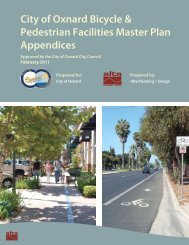Santa Clara River Trail Final Master Plan - Development Services ...
Santa Clara River Trail Final Master Plan - Development Services ...
Santa Clara River Trail Final Master Plan - Development Services ...
You also want an ePaper? Increase the reach of your titles
YUMPU automatically turns print PDFs into web optimized ePapers that Google loves.
Chapter 6: Design Guidelines, Maintenance Schedules and Best Practices<br />
<strong>Trail</strong> Design Features<br />
In addition to trail surface material, there are many other design elements that range from essential to the<br />
development of the trail, to amenities that benefit trail users and minimize trail impacts. This section<br />
addresses those features.<br />
Access Control<br />
Bollards<br />
Bollards are an effective way of keeping motor vehicle traffic off of trails (Figure 10). They are relatively<br />
inexpensive and should be installed to be removed or should be flexible to allow passage of maintenance<br />
or emergency vehicles. Solid bollards that are secured to the base with a lock should use combination<br />
locks only. A single bollard located in the center of a trail entrance can be enough to keep cars out while<br />
multiple closely spaced bollards or bollards with a chain in between may be used to separate a path from<br />
a parallel roadway.<br />
Minimize the use of bollards to avoid creating obstacles for bicyclists. Bollards, particularly solid<br />
bollards, have caused serious injury to bicyclists. Instead, design the path entry and use signage to alert<br />
drivers that motor vehicles are prohibited. Bollards also are used to slow down cyclists approaching a<br />
street crossing.<br />
Flexible bollards and posts are designed to give way on impact and can be used instead of steel or solid<br />
posts (see Figure 11). These bollards are typically made of plastic that is bolted to the roadway and bend<br />
and return to their original position when hit. They are intended to deter access, but allow vehicles<br />
through in an emergency.<br />
Bollards typically are installed using one of two<br />
methods:<br />
1) The bollard is set into concrete footing in the<br />
ground (see Figure 11).<br />
2) The bollard is attached to the surface by<br />
mechanical means (bolting the bollards or<br />
using epoxy glue and bolts (see Figure 12).<br />
Figure 10. Bollards are used at road crossings<br />
to keep motor vehicle traffic off trails.<br />
78 | Alta <strong>Plan</strong>ning + Design
















